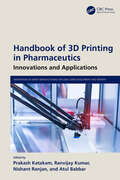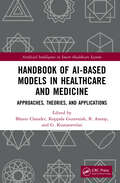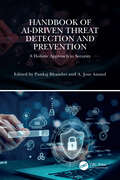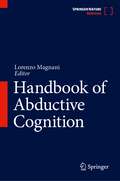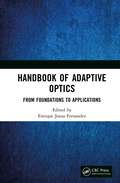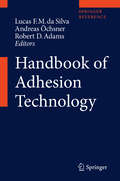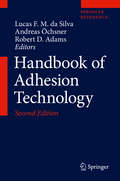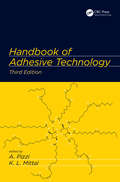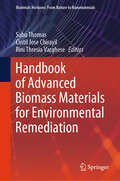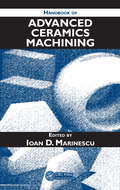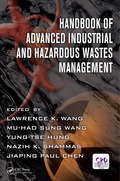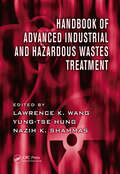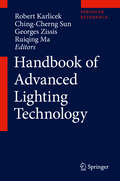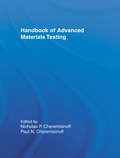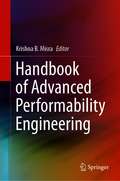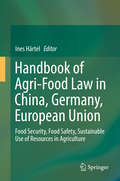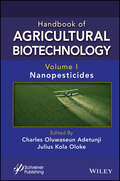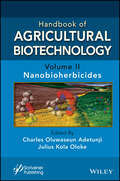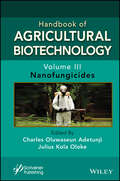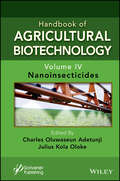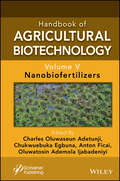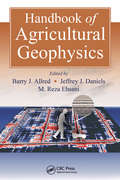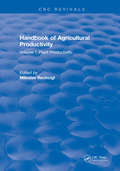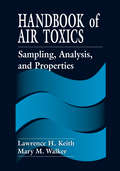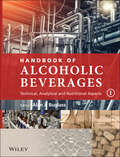- Table View
- List View
Handbook of 3D Printing in Pharmaceutics: Innovations and Applications (Innovations in Smart Manufacturing for Long-Term Development and Growth)
by Ranvijay Kumar Atul Babbar Nishant Ranjan Prakash KatakamThree-dimensional (3D) printing has evolved as an emerging tool for the design of customized or personalized medication that provides the maximum therapeutic benefits to patients. The manufacturing of medicines in small batches customized with tailored dosages, sizes, shapes, and drug release properties is the key prospect of using 3D printing in pharmaceutics.Handbook of 3D Printing in Pharmaceutics: Innovations and Applications provides a detailed and in-depth technical discussion on the various additive manufacturing processes for the development of pharmaceutical products with experimental justification. It details the characterization, optimization, and numerical modeling of the processes involved and outlines the industrial implications of the resulting products as well as offering solutions for patient- tailored drugs processed by additive manufacturing. The handbook goes on to focus on the various post- processing technologies available to fortify the mechanical, chemical, biological, geometrical, and other characteristics of additively manufactured components and also discusses future directions and possible research gaps that need to be filled.The buyers of this cutting-edge handbook will learn the complete information and methodology for manufacturing drug delivery systems and customized medicine for biomedical applications. It is an ideal read for undergraduates, graduates, and postgraduate research scholars. Industrial and academic professionals working and studying industrial, manufacturing, and production engineering, along with those studying mechanical engineering, pharmaceutical sciences, material science, chemical engineering, biomedical engineering, automobile/aerospace engineering, and other relevant domains will want this handbook at their fingertips.
Handbook of AI-Based Models in Healthcare and Medicine: Approaches, Theories, and Applications (Artificial Intelligence in Smart Healthcare Systems)
by Bhanu Chander, Koppala Guravaiah, B. Anoop, and G. KumaravelanThis handbook provides thorough, in-depth, and well-focused developments of artificial intelligence (AI), machine learning (ML), deep learning (DL), natural language processing (NLP), cryptography, and blockchain approaches, along with their applications focused on healthcare systems.Handbook of AI-Based Models in Healthcare and Medicine: Approaches, Theories, and Applications highlights different approaches, theories, and applications of intelligent systems from a practical as well as a theoretical view of the healthcare domain. It uses a medically oriented approach in its discussions of human biology, healthcare, and medicine and presents NLP-based medical reports and medicine enhancements. The handbook includes advanced models of ML and DL for the management of healthcare systems and also discusses blockchain-based healthcare management. In addition, the handbook offers use cases where AI, ML, and DL can help solve healthcare complications.Undergraduate and postgraduate students, academicians, researchers, and industry professionals who have an interest in understanding the applications of ML/DL in the healthcare setting will want this reference on their bookshelf.
Handbook of AI-Driven Threat Detection and Prevention: A Holistic Approach to Security
by Pankaj Bhambri A. Jose AnandIn today’s digital age, the risks to data and infrastructure have increased in both range and complexity. As a result, companies need to adopt cutting-edge artificial intelligence (AI) solutions to effectively detect and counter potential threats. This handbook fills the existing knowledge gap by bringing together a team of experts to discuss the latest advancements in security systems powered by AI. The handbook offers valuable insights on proactive strategies, threat mitigation techniques, and comprehensive tactics for safeguarding sensitive data.Handbook of AI-Driven Threat Detection and Prevention: A Holistic Approach to Security explores AI-driven threat detection and prevention, and covers a wide array of topics such as machine learning algorithms, deep learning, natural language processing, and so on. The holistic view offers a deep understanding of the subject matter as it brings together insights and contributions from experts from around the world and various disciplines including computer science, cybersecurity, data science, and ethics. This comprehensive resource provides a well-rounded perspective on the topic and includes real-world applications of AI in threat detection and prevention emphasized through case studies and practical examples that showcase how AI technologies are currently being utilized to enhance security measures. Ethical considerations in AI-driven security are highlighted, addressing important questions related to privacy, bias, and the responsible use of AI in a security context. The investigation of emerging trends and future possibilities in AI-driven security offers insights into the potential impact of technologies like quantum computing and blockchain on threat detection and prevention.This handbook serves as a valuable resource for security professionals, researchers, policymakers, and individuals interested in understanding the intersection of AI and security. It equips readers with the knowledge and expertise to navigate the complex world of AI-driven threat detection and prevention. This is accomplished by synthesizing current research, insights, and real-world experiences.
Handbook of Abductive Cognition
by Lorenzo MagnaniThis Handbook offers the first comprehensive reference guide to the interdisciplinary field of abductive cognition, providing readers with extensive information on the process of reasoning to hypotheses in humans, animals, and in computational machines. It highlights the role of abduction in both theory practice: in generating and testing hypotheses and explanatory functions for various purposes and as an educational device. It merges logical, cognitive, epistemological and philosophical perspectives with more practical needs relating to the application of abduction across various disciplines and practices, such as in diagnosis, creative reasoning, scientific discovery, diagrammatic and ignorance-based cognition, and adversarial strategies. It also discusses the inferential role of models in hypothetical reasoning, abduction and creativity, including the process of development, implementation and manipulation for different scientific and technological purposes. Written by a group of internationally renowned experts in philosophy, logic, general epistemology, mathematics, cognitive, and computer science, as well as life sciences, engineering, architecture, and economics, the Handbook of Abductive Cognition offers a unique reference guide for readers approaching the process of reasoning to hypotheses from different perspectives and for various theoretical and practical purposes. Numerous diagrams, schemes and other visual representations are included to promote a better understanding of the relevant concepts and to make concepts highly accessible to an audience of scholars and students with different scientific backgrounds.
Handbook of Adaptive Optics: From Foundations to Applications
by Enrique Josua FernandezAdaptive Optics (AO) is a technique allowing the manipulation of the wavefront of the light benefitting multiple fields like Microscopy, Optical Coherence Tomography, Visual Testing, Optical Communications, and Astronomical Optics, just to mention some examples. Handbook of Adaptive Optics contains a complete picture of the technique from the foundations to the most promising applications of AO in a variety of fields.Within this book, the reader will find different sections, including: a complete and rigorous introduction to the foundation of the technique from a general perspective, providing the reader a solid basis in AO with particular emphasis on wavefront sensing methods and aberration correctors. It also discusses state-of-the-art applications and industrial usages with their particular constraints and methods to incorporate AO, like in some imaging techniques of importance for Biomedical Optics, in Astronomy and for Visual Optics. Furthermore, it explores discussions of the future of AO together with some of the most exciting emerging applications, including quantum technologies, scattering correction, space telescopes, and discrete AO, among others.This timely handbook will be an important companion to those starting in the field, but it will also serve as a comprehensive resource for researchers and experts who are already working with AO.
Handbook of Adhesion Technology
by Andreas Öchsner Robert D. Adams Lucas F. SilvaAdhesives have been used for thousands of years, but until 100 years ago, the vast majority was from natural products such as bones, skins, fish, milk, and plants. Since about 1900, adhesives based on synthetic polymers have been introduced, and today, there are many industrial uses of adhesives and sealants. It is difficult to imagine a product--in the home, in industry, in transportation, or anywhere else for that matter--that does not use adhesives or sealants in some manner. The Handbook of Adhesion Technology is intended to be the definitive reference in the field of adhesion. Essential information is provided for all those concerned with the adhesion phenomenon. Adhesion is a phenomenon of interest in diverse scientific disciplines and of importance in a wide range of technologies. Therefore, this handbook includes the background science (physics, chemistry and materials science), engineering aspects of adhesion and industry specific applications. It is arranged in a user-friendly format with ten main sections: theory of adhesion, surface treatments, adhesive and sealant materials, testing of adhesive properties, joint design, durability, manufacture, quality control, applications and emerging areas. Each section contains about five chapters written by internationally renowned authors who are authorities in their fields. This book is intended to be a reference for people needing a quick, but authoritative, description of topics in the field of adhesion and the practical use of adhesives and sealants. Scientists and engineers of many different backgrounds who need to have an understanding of various aspects of adhesion technology will find it highly valuable. These will include those working in research or design, as well as others involved with marketing services. Graduate students in materials, processes and manufacturing will also want to consult it.
Handbook of Adhesion Technology
by Andreas Öchsner Robert D. Adams Lucas F. M. da SilvaThis 2nd edition is a complete revision with an update of the methods that have been investigated recently and that are now fully accepted by the adhesion community. Themes that are now treated in more detail include for example hybrid adhesives used for automotive applications, ecofriendly surface treatments, damage mechanics, joint durability prediction and functionally graded joints. There is also a new chapter related to the application of adhesives in the oil industry. Besides these content changes, there has been a complete revision of all chapters in terms of text, figures, tables and references for a more didactic character of this reference book. The Handbook of Adhesion Technology is intended to be the definitive reference in the field. Essential information is provided for all those concerned with adhesion, which is a phenomenon of interest in diverse scientific disciplines and of importance in a wide range of technologies. Therefore, this book includes the background science (physics, chemistry and materials science), engineering aspects and industry-specific applications. It is arranged in a user-friendly format with ten main sections: theory of adhesion, surface treatments, adhesive and sealant materials, testing of adhesive properties, joint design, durability, manufacture, quality control, applications and emerging areas. Each section contains about five chapters written by internationally renowned authors who are authorities in their fields. This book offers a quick, but authoritative, description of topics in the field of adhesion and the practical use of adhesives and sealants. Scientists and engineers of many different backgrounds who need to have an understanding of various aspects of adhesion technology will find it highly valuable. These will include those working in research or design, as well as others involved with marketing services. Graduate students in materials, processes and manufacturing will also want to consult it.
Handbook of Adhesive Technology
by Antonio Pizzi Kashmiri L. MittalThis classic reference examines the mechanisms driving adhesion, categories of adhesives, techniques for bond formation and evaluation, and major industrial applications. Integrating recent innovation and improved instrumentation, the work offers broad and comprehensive coverage. This edition incorporates several new adhesive classes, new application topics, and recent developments with nanoadhesives and bio-based adhesives. Existing chapters are thoroughly updated, revised, or replaced and authored by top specialists in the field. Abundant figures, tables, and equations appear throughout the work.
Handbook of Advanced Biomass Materials for Environmental Remediation (Materials Horizons: From Nature to Nanomaterials)
by Sabu Thomas Cintil Jose Chirayil Rini Thresia VargheseThis book explores the functional materials derived from biomass for environmental remediation applications. It covers different sources of biomass, its classification, production and various functional materials that are derived from them and suitable for energy production. Various topics covered in this book include classification of biomass, conversion and utilization techniques, functional materials, different applications in environmental remediation, biofuels and many more. This book is highly useful for students, researchers and professionals working in the field of materials and environmental science.
Handbook of Advanced Ceramics Machining
by Ioan D. MarinescuCeramics, with their unique properties and diverse applications, hold the potential to revolutionize many industries, including automotive and semiconductors. For many applications, ceramics could replace metals and other materials that are more easily and inexpensively machined. However, current ceramic machining methods remain cost-prohibitive. F
Handbook of Advanced Industrial and Hazardous Wastes Management (Advances in Industrial and Hazardous Wastes Treatment #7)
by Lawrence K. Wang Yung-Tse Hung Nazih K. Shammas Jiaping Paul Chen Mu-Hao S. WangThis volume provides in-depth coverage of environmental pollution sources, waste characteristics, control technologies, management strategies, facility innovations, process alternatives, costs, case histories, effluent standards, and future trends in waste treatment processes. It delineates methodologies, technologies, and the regional and global effects of important pollution control practices. It focuses on specific industrial and manufacturing wastes and their remediation. Topics include: heavy metals, electronics, chemical, and textile manufacturing.
Handbook of Advanced Industrial and Hazardous Wastes Treatment (Advances in Industrial and Hazardous Wastes Treatment #7)
by Lawrence K. Wang Yung-Tse Hung Nazih K. ShammasMost industrial and hazardous waste management resources cover the major industries and provide conventional in-plant pollution control strategies. Until now however, no book or series of books has provided coverage that includes the latest developments in innovative and alternative environmental technology, design criteria, managerial decision met
Handbook of Advanced Lighting Technology
by Robert Karlicek Ching-Cherng Sun Georges Zissis Ruiqing MaThe Handbook of Advanced Lighting Technology is a major reference work on the subject of light source science and technology, with particular focus on solid-state light sources - LEDs and OLEDs - and the development of 'smart' or 'intelligent' lighting systems; and the integration of advanced light sources, sensors, and adaptive control architectures to provide tailored illumination which is 'fit to purpose. ' The concept of smart lighting goes hand-in-hand with the development of solid-state light sources, which offer levels of control not previously available with conventional lighting systems. This has impact not only at the scale of the individual user, but also at an environmental and wider economic level. These advances have enabled and motivated significant research activity on the human factors of lighting, particularly related to the impact of lighting on healthcare and education, and the Handbook provides detailed reviews of work in these areas. The potential applications for smart lighting span the entire spectrum of technology, from domestic and commercial lighting, to breakthroughs in biotechnology, transportation, and light-based wireless communication. Whilst most current research globally is in the field of solid-state lighting, there is renewed interest in the development of conventional and non-conventional light sources for specific applications. This Handbook comprehensively reviews the basic physical principles and device technologies behind all light source types and includes discussion of the state-of-the-art. The book essentially breaks down into five major sections: Section 1: The physics, materials, and device technology of established, conventional, and emerging light sources, Section 2: The science and technology of solid-state (LED and OLED) light sources, Section 3: Driving, sensing and control, and the integration of these different technologies under the concept of smart lighting, Section 4: Human factors and applications, Section 5: Environmental and economic factors and implications
Handbook of Advanced Materials Testing (Materials Engineering)
by Nicholas P. Cheremisinoff Paul N. CheremisinoffThis work discusses techniques for developing new engineering materials such as elastomers, plastic blends, composites, ceramics and high-temperature alloys. Instrumentation for evaluating their properties and identifying potential end uses are presented.;The book is intended for materials, manufacturing, mechanical, chemical and metallurgical engi
Handbook of Advanced Performability Engineering
by Krishna B. MisraThis book considers all aspects of performability engineering, providing a holistic view of the activities associated with a product throughout its entire life cycle of the product, as well as the cost of minimizing the environmental impact at each stage, while maximizing the performance. Building on the editor's previous Handbook of Performability Engineering, it explains how performability engineering provides us with a framework to consider both dependability and sustainability in the optimal design of products, systems and services, and explores the role of performability in energy and waste minimization, raw material selection, increased production volume, and many other areas of engineering and production. The book discusses a range of new ideas, concepts, disciplines, and applications in performability, including smart manufacturing and Industry 4.0; cyber-physical systems and artificial intelligence; digital transformation of railways; and asset management. Given its broad scope, it will appeal to researchers, academics, industrial practitioners and postgraduate students involved in manufacturing, engineering, and system and product development.
Handbook of Agri-Food Law in China, Germany, European Union: Food Security, Food Safety, Sustainable Use of Resources in Agriculture
by Ines HärtelThis book offers a new and differentiated overview of Agri-Food Law against the background of national and global integration of markets, and compares for the first time important aspects of the agricultural, environmental and food law of China and Germany / the European Union. In addition to the basics, it discusses a wide range of issues, such as the respective legal regulatory structures for food security, food safety, geographical indications of origin, climate protection, fertilizers, plant protection products, genetic engineering, water protection, soil protection, land resources and organic farming. In addition, it addresses key environmental impacts and developments in order to create integrated value chains. The increasing fusion of upstream and downstream areas is becoming apparent from primary production, to the refinement and trade up level, and even to consumption. Agri-Food Law is now productively taking these important developments into account with regard to the aforementioned countries.
Handbook of Agricultural Biotechnology, Volume 1: Nanopesticides (Handbook of Agricultural Bionanobiotechnology)
by Charles Oluwaseun Adetunji Julius Kola OlokeHandbook of AGRICULTURAL BIOTECHNOLOGY The book provides detailed information on the application of nanopesticides for the management of numerous agricultural pests and pathogens, as well as to foster an innovative pathway toward future sustainable agriculture and food systems. Biopesticides have been identified as a sustainable and permanent replacement to synthetic chemicals. Their application will go a long way toward preventing major challenges that confront sustainable agriculture, the actualization of global food production and food security, helping to feed an ever-increasing population that is predicted to increase to nine billion by 2050. An interdisciplinary collaboration among policymakers, private sector, researchers, civil society, farmers, consumers, and environmentalists will foster an innovative pathway toward future sustainable agriculture and food systems that could ensure resilience, food security, and a healthy environment. The book explains the application of some nanobiopesticides as ovicides that could kill eggs of insects and mites, as well as slimicides that could destroy slime-producing microorganisms, such as algae, bacteria, fungi, and slime molds. Other highlights include: a discussion on the application of nanobiopesticides for the rejuvenation of heavily contaminated environments (as well as their role in the mitigation of several abiotic stress); a demonstration of how nanobiopesticides derived from plants could be applied for effective management of pests and diseases in animal husbandry and fishery; and a collection of relevant information on patents, the commercialization of relevant plant-derived nanobiopesticides, and their social economic and industrial relevance. Audience The book is a useful resource for a diverse audience, including industrialists, food industry professionals, agriculturists, agricultural microbiologists, plant pathologists, botanists, microbiologists, biotechnologists, nanotechnologists, microbial biotechnologists, farmers, policymakers, and extension workers.
Handbook of Agricultural Biotechnology, Volume 2: Nanobioherbicides (Handbook of Agricultural Bionanobiotechnology)
by Charles Oluwaseun Adetunji Julius Kola OlokeHandbook of AGRICULTURAL BIOTECHNOLOGY The book provides a detailed examination of the application of nanobioherbicides that come from plants including information on the different metabolites derived from numerous plants that could become bioherbicides. The book gives attention to weed-plant physiology and chronicles the activities of nanobioherbicides on weeds during preliminary bioassays, pot assays, in-house screenings, and during field trials. Furthermore, deep data is provided on the commercial potential of these nanobioherbicides derived from plants, while toxicity assays are also highlighted. Other topics covered include: documented patents on nanobioherbicides; the process involved in the registration of these novel products as nanobioherbicides for both conventional and organic farming; relevant information on the application of molecular techniques for improvement of nanobioherbicides, such as genomics, proteomics, informatics, bioinformatics, and chemoinformatics; details about the non-target effect of the nanobioherbicides. Highlighted, too, is information on the biochemical, enzymatic, and ultrastructural effects of these nanobioherbicides, as well as detailed information on the nutritional qualities of agricultural crops after nanobioherbicidal application. Audience The book is a useful resource for a diverse audience, including industrialists, food industry professionals, agriculturists, agricultural microbiologists, plant pathologists, botanists, microbiologists, biotechnologists, nanotechnologists, microbial biotechnologists, farmers, policymakers, and extension workers.
Handbook of Agricultural Biotechnology, Volume 3: Nanofungicides (Handbook of Agricultural Bionanobiotechnology)
by Charles Oluwaseun Adetunji Julius Kola OlokeHandbook of AGRICULTURAL BIOTECHNOLOGY This book provides state-of-the-art information about recent advancements in the application of nanobiofungicides for effective management of post-harvest diseases and agricultural fungal diseases, including blights, mildews, molds, and rusts. The book details the formulation and standardization of nanobiofungicides, as well as their application in the management of biotic and abiotic stress. It provides relevant information on the isolation, characterization, purification, and structural characterization of active constituents, using spectroscopic techniques and explains the quarantine and regulatory issues that are associated with nanobiofungicides (derived from plants and other biogenic sources), as well as various regulatory bodies that manage the control of pesticides on agricultural products. Readers will learn about the application of nanobiofungicides when applied as a biocontrol agent against soil-borne and root-borne plant pathogens; the management of mycotoxin; the non-target effect of plant-based nanobiofungicides when applied in the greenhouse and field (such as rate of CO2 evolution, organic carbon content, enzymatic activity, acidic and alkaline phosphatase, dehydrogenases, urease, and protease); and the effect on soil microorganisms using different assay techniques. Furthermore, the book provides information on several plant materials that could serve as nanobiofungicdes, and explains the procedure involved in the characterization of plant-based nanobiofungicides (using TEM, SEM, XRD, EDX, UV, zeta potential, dynamic light-scattering). Finally, it offers a specific illustration on the application of microencapsulation and nanoformulation technology in the synthesis of plant-based nanobiofungicides. Audience The book is a useful resource for a diverse audience, including industrialists, food industry professionals, agriculturists, agricultural microbiologists, plant pathologists, botanists, microbiologists, biotechnologists, nanotechnologists, microbial biotechnologists, farmers, policymakers, and extension workers.
Handbook of Agricultural Biotechnology, Volume 4: Nanoinsecticides (Handbook of Agricultural Bionanobiotechnology)
by Charles Oluwaseun Adetunji Julius Kola OlokeHandbook of AGRICULTURAL BIOTECHNOLOGY The book provides detailed information about the application of repellent products that contain plant-based ingredients known as nanobioinsecticides, including the pesticide evaluation scheme guidelines for repellent testing, relevant information about the procedures to evaluate several repellent compounds, the development of new products that offer high repellency, and guidelines for consumer safety. The chapters of volume IV of this set, focus on a wide range of related topics. They chronicle many traditional repellent plants that could be used in ethnobotanical studies and provides valuable insight into the development of new natural products. It outlines the standardization and numerous investigations used to affirm the level of repellent compounds from various plants. Furthermore, it details the safety, efficacy, and facts about plant-based repellent testing, and reviews new developments in the field. The book also explores the sustainable techniques involved in the structural elucidation and characterization of active constituents found in nanobioinsecticides, and gives relevant information on the use of essential oils, derived from plants, in the preparation of nanobioinsecticides. Audience The book is a useful resource for a diverse audience, including industrialists, food industry professionals, agriculturists, agricultural microbiologists, plant pathologists, botanists, microbiologists, biotechnologists, nanotechnologists, microbial biotechnologists, farmers, policymakers, and extension workers.
Handbook of Agricultural Biotechnology, Volume 5: Nanobiofertilizers (Handbook of Agricultural Bionanobiotechnology)
by Chukwuebuka Egbuna Charles Oluwaseun Adetunji Anton Ficai Oluwatosin Ademola IjabadeniyiThis book details recent advances in the applications of nanobiofertilizers as a substitute for synthetic fertilizers in boosting food production. With the steady rise of the world’s population, there is a need to increase the production of safe and nutritious food. The constant loss of arable land, as a result of various anthropogenic activities from human action, has become a threat to global biodiversity and ecosystems. Additionally, the issue of climate change has imposed many obstacles to increasing agricultural productivity, especially from biotic and abiotic stressors and temperature-limited environments, such as in high altitudes or seasonally hot regions. Because of these factors, there is a need to adopt sustainable and modern technologies that can boost and improve the rate of food production. One of the cheapest means of enhancing sustainable food production is to explore natural and unlimited beneficial microorganisms, particularly those that can increase the level of soil fertility, improve crop production and health, improve tolerance to stress, support nutrient uptake and availability, and boost natural biodiversity. The synergetic effect of nanotechnology and beneficial microorganisms for the effective bio-fabrication of nanobiofertilizers, is a sustainable solution for producing pesticide-free food. This book provides a deep insight into microbial diversity, recent techniques used for the isolation, screening, and characterization of beneficial microorganisms with eco-friendly attributes, used for bioengineering of nanobiofertilizers, as well as the application of proteomics, metabolomics, genomics, and bioinformatics. The book also covers commercialization, patents, and the business and socio-economic aspects of nanobiofertilizers, as well as the role of policymakers, stakeholders, and government agencies in the translation of nanobioferilizer research into policy. Audience The book is a useful resource for a diverse audience, including industrialists, food industry professionals, agriculturists, agricultural microbiologists, plant pathologists, botanists, microbiologists, biotechnologists, nanotechnologists, microbial biotechnologists, farmers, policymakers, and extension workers.
Handbook of Agricultural Geophysics (500 Tips)
by Barry J. Allred Jeffery J. Daniels M. Reza EhsaniPrecision farming, site infrastructure assessment, hydrologic monitoring, and environmental investigations- these are just a few current and potential uses of near-surface geophysical methods in agriculture. Responding to the growing demand for this technology, the Handbook of Agricultural Geophysics supplies a clear, concise overview of nea
Handbook of Agricultural Productivity: Volume I: Plant Productivity (Crc Series In Nutrition And Food)
by Miloslav RechciglThe greatest challenge of our time is to produce sufficient food ot keep pace with the rapidly growing population. In the opinion of experts, during the next 25 years there will be a need for as much food as was produced in the entire history of mankind to date. Of the various measures available, improvement in agricultural productivity is judged as the ultimate means of augmenting food production and supplies. In this Handbook, an international team of experts consider the most important factors affecting production of both crops and livestock. This Handbook is intended as a scientific guide to practitioners and students, as well as to researchers, who should find here stimulating ideas for further exploration.
Handbook of Air Toxics: Sampling, Analysis, and Properties
by Mary Walker Lawrence H. KeithThe Handbook of Air Toxics compiles, defines, and clarifies several methods and concepts of airborne toxic substances found in the environment. This comprehensive reference helps regulators, consultants, and other environmental professionals meet the challenges of sampling and analysis, emissions reductions, and health and safety issues related to human exposure. It is an important reference addressing the ongoing concern about the consequences of air pollution, and the implementation and modification of the Environmental Protection Agency's (EPA) Clean Air Act.Some of the methods described in the Handbook of Air Toxics include fluorescence, thermal desorption, selected ion monitoring, ion chromatography, light microscopy, specific electrode analysis, titration, colorimetry, atomic absorption, and spectrophotometry. It also covers the use of isokinetic sampling trains, midget impingers, carbon molecular sieves, and sampling canisters in the analysis of air toxics. The Handbook also contains recommendations from the EPA for analytical methods for those air toxics where methods do not already exist and provides advance information on future method development by the EPA.
Handbook of Alcoholic Beverages
by Alan J. BuglassA comprehensive two- volume set that describes the science and technology involved in the production and analysis of alcoholic beverages.At the heart of all alcoholic beverages is the process of fermentation, particularly alcoholic fermentation, whereby sugars are converted to ethanol and many other minor products. The Handbook of Alcoholic Beverages tracks the major fermentation process, and the major chemical, physical and technical processes that accompany the production of the world's most familiar alcoholic drinks. Indigenous beverages and small-scale production are alsocovered to asignificant extent.The overall approach is multidisciplinary, reflecting the true nature of the subject. Thus, aspects of biochemistry, biology (including microbiology), chemistry, health science, nutrition, physics and technology are all necessarily involved, but the emphasis is on chemistry in many areas of the book. Emphasis is also on more recent developments and innovations, but there is sufficient background for less experienced readers. The approach is unified, in that although different beverages are dealt with in different chapters, there is extensive cross-referencing and comparison between the subjects of each chapter.Divided into five parts, this comprehensive two-volume work presents:INTRODUCTION, BACKGROUND AND HISTORY: A simple introduction to the history and development of alcohol and some recent trends and developments,FERMENTED BEVERAGES: BEERS, CIDERS, WINES AND RELATED DRINKS: the latest innovations and aspects of the different fermentation processes used in beer, wine, cider, liquer wines, fruit wines, low-alcohol and related beverages.SPIRITS: cover distillation methods and stills used in the production of whisky, cereal- and cane-based spirits, brandy, fruit spirits and liquersANALYTICAL METHODS: covering the monitoring of processes in the production of alcoholic beverages, as well as sample preparation, chromatographic, spectroscopic, electrochemical, physical, sensory and organoleptic methods of analysis.NUTRITION AND HEALTH ASPECTS RELATING TO ALCOHOLIC BEVERAGES: includes a discussion on nutritional aspects, both macro- and micro-nutrients, of alcoholic beverages, their ingestion, absorption and catabolism, the health consequences of alcohol, and details of the additives and residues within the various beverages and their raw materials.
